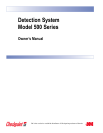
Training your staff
Unwanted alarms
Your detection system is unlikely to experience false alarms. Occasionally your system may alarm and your staff may find that
the patron does not have unauthorized library materials. False alarms may be caused by active strips on items carried into
the library such as books from another library.
False alarms are generally infrequent and will vary depending on the patrons and the proximity of your library to facilities
that are releasing items containing security strips. Because it is not possible to distinguish between false alarms and alarms
with potential item loss, all responses to alarms must be consistent and follow your management policies. If patrons see no
response to alarms, the system becomes less effective. When you decide that a security strip on an item from outside your
library caused an alarm, follow these steps:
1. Explain the problem to the patron.
2. Verify that all of the patron’s library materials are properly checked out.
3. Allow the patron to exit the library.
Many patrons will learn from the experience and will not carry items that may cause alarms into the library.
Alarm log
The alarm log is used to keep a record of details involving alarms that occur. See the Detection System Alarm Log. For each
alarm, record the information on the log. Keeping this log up-to-date provides a key tool for monitoring system activity. An
up-to-date alarm log provides useful information for library management and your 3M service representative.
Detection system alarm log
Alarm
Date Time
Patron
Count
Reported By
*Alarm
Reason
(1, … 5)
$ Value of
Recovered
Materials
Description of
Recovered Materials
Copyright © 2008. 3M. All rights reserved.
5


















